Four Lavender Farm Gardeners Share Their Recommended Companion Plants

Reviewed By ROY NICOL

Roy is a Professional Gardener and Horticultural Consultant, specialising in large garden year-round maintenance and garden development. He is an RHS Master of Horticulture and uses his research in the application of no-dig methods in ornamental garden settings. Roy has been a Professional Gardener for more than six years and is a member of the Chartered Institute of Horticulture, Professional Gardener's Guild and Association of Professional Landscapers (Professional Gardener).
Contributions From JULIA SNOWBALL

Julia is the Head Gardener at Yorkshire Lavender, a lavender farm based in West Yorkshire that is home to over 60 acres of land that is adorned by a huge array of lavender varieties and other herbs.

Owners of The Lavender Fields, the Butler family have been growing lavender commercially for nearly 25 years. Nick and Lyndsay are based in Hampshire and have invaluable experience in all aspects of lavender growing.

An Arable Farmer based in the Cotswold district. In 1999, Charlie began growing his own lavender and, more than 20 years later, is now the Owner of Cotswold Lavender, home to over 70 acres of lavender varieties.

Patrick is the MD of Fairweather’s Nursery, which is home to a Plant Heritage National Collection of Agapanthus. Their Allium cultivar won the HTA Plant Of The Year Award in 2021 and came 2nd in the same category at the Chelsea Flower Show in the same year. Patrick is also the Chair of the RHS Agapanthus AGM trials.
IN THIS GUIDE
- Companions Chosen By The Experts
- 1) Oregano
- 2) Bee Balm
- 3) Thyme
- 4) Ice Plant
- 5) Celery
- 6) Sweet Basil
- 7) Ornamental Onion
- 8) Rose Shrub
- 9) Yarrow
- 10) Ruby Grass
- 11) Sage
- 12) Purple Coneflower
- 13) Broccoli
- 14) Cardinal Flower
- 15) African Daisy
- 16) Parsley
- 17) Baby’s Breath
- 18) Black-Eyed Susan
- 19) Rosemary
- 20) Blue Fescue
- References
LAVENDER GUIDES
Companion Plants
Cuttings
French Lavender
Harvesting
Lavender Hedging
Pruning
Varieties
Winter
Lavender is a wonderful aromatic shrub with evergreen foliage that is popular in herb gardens or traditional cottage planting schemes.
With a preference for a sheltered position in full sun, it will need to be grown alongside other plants that can also tolerate and thrive in these conditions.
Companions Chosen By The Experts
Nick and Lyndsay Butler are the co-owners of Lavender Fields, a lavender farm based in the heart of Hampshire.
“Lavender is a good bed mate with most plants,” say the Butlers.
“The most important thing to consider for companions is size, given the vast number of lavender varieties available, especially from specialists like us, can range from 0.2-1m in height and width when fully grown.

“If you are planting at the front of a border, you may want to consider a dwarf variety. If it is a large space you are looking to fill, you will want a larger growing variety.
“The same consideration should be given to the companion plant.”
So, what do Nick and Lyndsay grow with their lavender?
“On the farm, we have planted lavender with roses, box hedging, and geraniums, to name just a few.
“It is also lovely to interplant them with spring flowering bulbs that provide some colour when the lavender is not flowering.”

Charlie Byrd is a farmer that has been growing his own lavender for nearly 25 years. He owns Cotswold Lavender, a specialist seller and farm in the southwest of England.
“We grow grass and clover between the rows of lavender on our farm,” shares Charlie.
“Grass is a natural weed suppressant and the clover, being a legume, naturally fixes nitrogen from the air and makes it available for the grass and lavender.”
“Lavender combines well with roses, but my favourite would be to interplant them with Echinacea ‘Sensation Pink’,” says Patrick Fairweather from Fairweather’s Nursery.
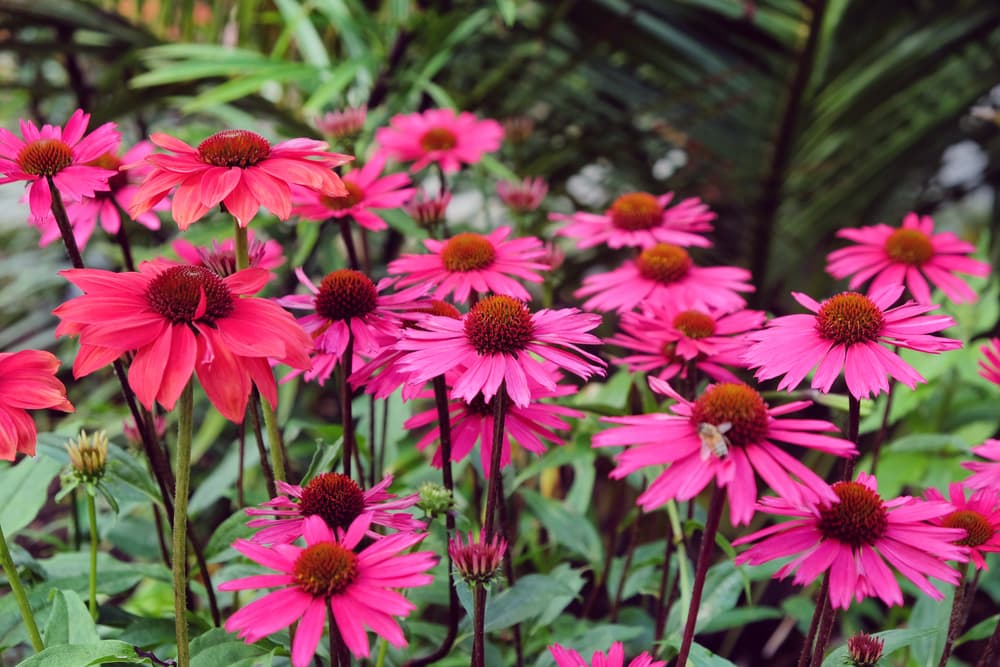
“This gives a flush of colour at the end of the summer.
“Planting spring bulbs and tall summer-flowering alliums also works well.”
“I find this works well as Echinacea flowers at the same time as Lavender (July in the UK) and also prefers a sandy well-drained loam soil,” adds Roy Nicol, Master Horticulturist.
Julia Snowball is the Head Gardener at Yorkshire Lavender, a huge lavender farm based in the north of England.
“At Yorkshire Lavender we grow Mexican Feather Grass among the lavenders to bring movement and contrast to the plantings.
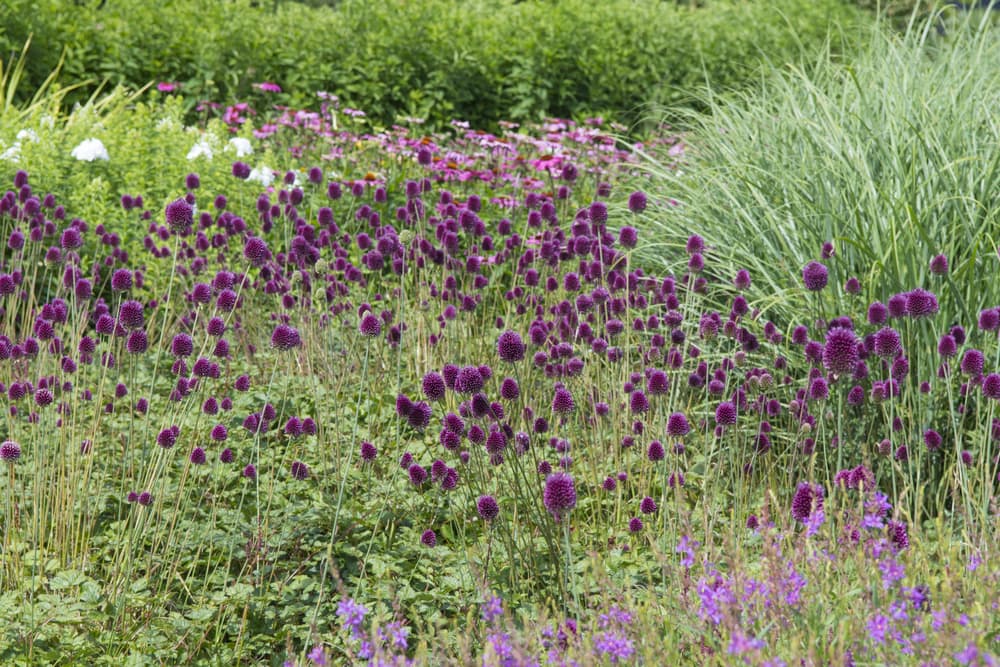
“We also have Allium sphaerocephalon dotted among some of the taller lavenders to add extra interest.”
In the rest of this guide, we share twenty companions to grow with your lavender – plants that not only can grow well in a similar position, but might also bring about added ornamental value or act as a good pest deterrent.
1) Oregano

- BOTANICAL NAME: Origanum vulgare
- HARDINESS RATING: H6
- PLANT TYPE: herb / perennial
- FLOWERS: pink
- FLOWERING SEASON(S): summer / autumn
- SIZE: 0.5-1m in height, 0.5-0.1m spread
Starting with another garden herb that is commonly grown here in the UK, oregano bears pink flowers on tall, erect stems in the summer and autumn that will look lovely next to the similarly built blooms of lavender.
Not only that, but oregano is also a great pest repellant as it attracts beneficial insects like lacewings that feast on aphids and other small flies that could potentially damage your lavender crop.
“In my experience, Oregano has a habit of spreading outwards, becoming a much larger plant over time and flopping over other nearby plants,” says Roy.
“To counter this, when it has been cut back in the autumn, I reduce the size of the plant with a sharp spade, replanting pieces elsewhere as required.”
2) Bee Balm

- BOTANICAL NAME: Monarda didyma
- HARDINESS RATING: H5
- PLANT TYPE: herb / perennial
- FLOWERS: pink and red
- FLOWERING SEASON(S): summer
- SIZE: 0.5-1m in height, 0.1-0.5m spread
Monarda didyma, more commonly referred to as bee balm, is a hardy perennial that is beloved by bees and other pollinators.
Also preferring a site in full sun, you can plant bee balm next to lavender if you have particularly loamy or sandy soil.
Like lavender, some varieties also produce purple flowers, but the petals of bee balm are frilly, growing up to 1m in height on top of upright, dark stems.
3) Thyme

- BOTANICAL NAME: Thymus vulgaris
- HARDINESS RATING: H5
- PLANT TYPE: shrub / herb
- FLOWERS: white and pink
- FLOWERING SEASON(S): summer
- SIZE: 0.1-0.5m in height, 0.1-0.5m spread
Thyme is another shrub that will look great when planted next to lavender, with its purply-white flowers making a nice companion to your purple-flowering lavender shrubs.
Both of these herbs thrive in full sun, poor well-drained soil and a sheltered location and will work well together in a herb garden planting scheme.
4) Ice Plant

- BOTANICAL NAME: Hylotelephium spectabile
- HARDINESS RATING: H7
- PLANT TYPE: perennial
- FLOWERS: pink
- FLOWERING SEASON(S): summer
- SIZE: 0.1-0.5m in height, 0.1-0.5m spread
With small pink flowers growing in clusters on stems up to 50cm in height, ice plants (often known as Sedum) make delightful additions to any garden displays, and, when grown next to lavender, they will also thrive in the full sun with minimal irrigation.
Sedums are low-maintenance perennials and will not require too much care when planted out.
Just make sure that the growing medium you are planting them in is not acidic, as these plants need an alkaline to neutral pH.
5) Celery
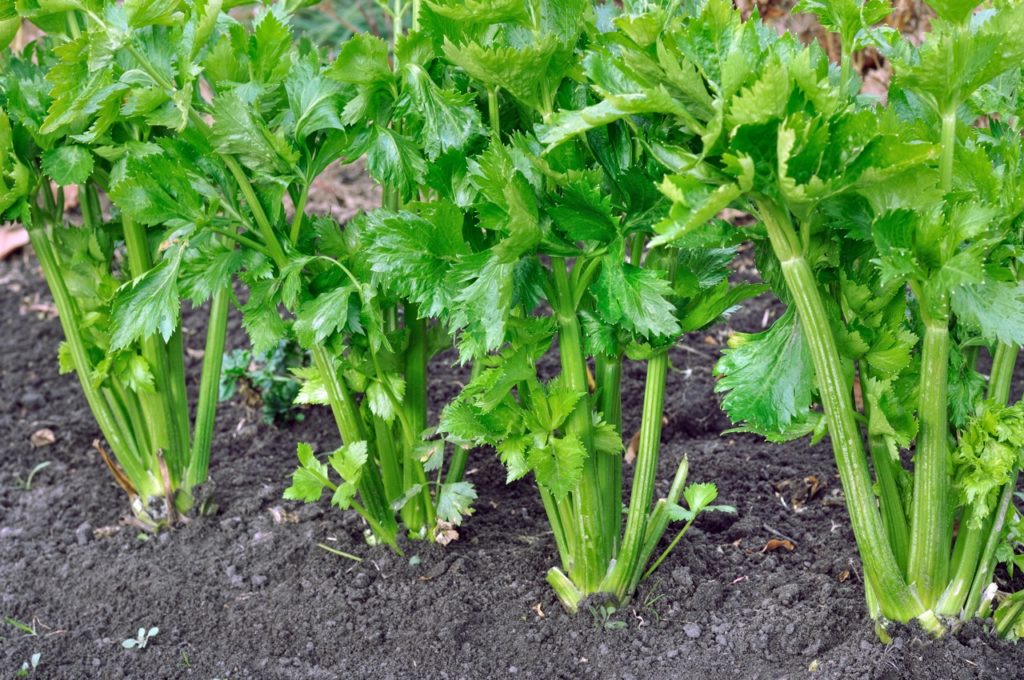
- BOTANICAL NAME: Apium graveolens
- HARDINESS RATING: H2
- PLANT TYPE: vegetable
- SIZE: 0.1-0.5m in height, 0-0.1m spread
The first and only vegetable on this list, celery makes a delightful addition to salads, soups and smoothies.
By planting celery with lavender, this vegetable will grow more readily, as lavender is said to repel white moths and the celery fly which are some of this veggie’s worst pests.1Why Can Lavender Be Used to Repel Moths? – The Chemistry of Lavender. (2017, July 10). Compound Interest. Retrieved March 21, 2023, from https://www.compoundchem.com/2017/07/10/lavender/
Do be aware before planting that celery requires quite a moist growing medium and will need to be watered more frequently than your lavender plants.
6) Sweet Basil
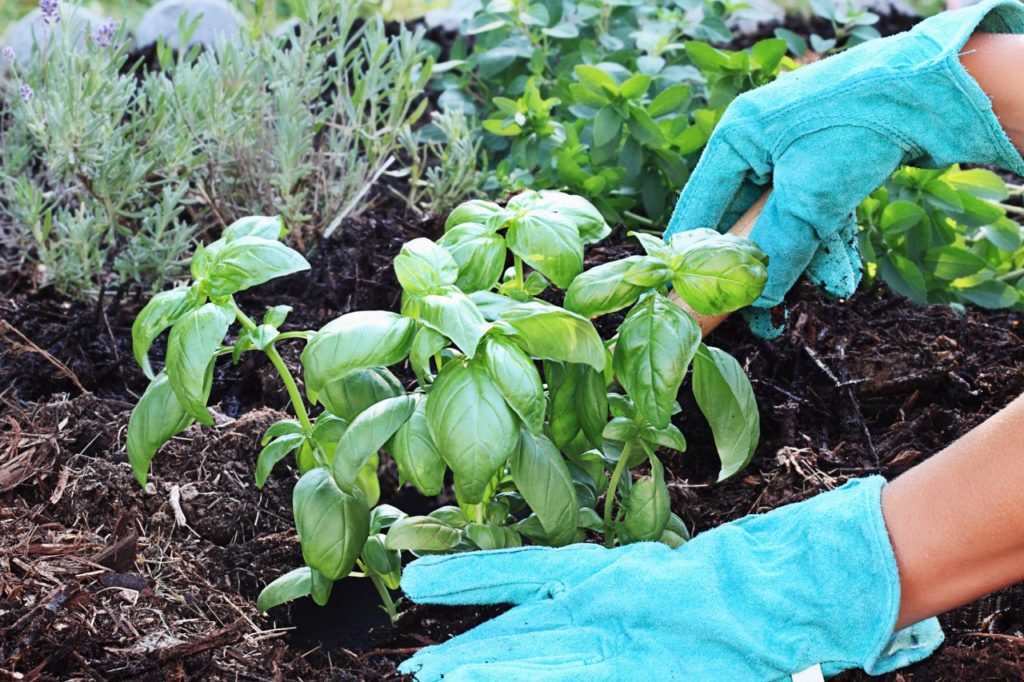
- BOTANICAL NAME: Ocimum basilicum
- HARDINESS RATING: H1C
- PLANT TYPE: annual / biennial
- FLOWERS: pink and white
- FLOWERING SEASON(S): summer
- SIZE: 0.1-0.5m in height, 0.1-0.5m spread
Sweet basil is one plant you won’t have to worry about in regards to additional watering, as it thrives in almost identical conditions to lavender.
Basil can act as a deterrent to aphids and other common pests that might affect lavender and therefore help it to grow more vigorously.
However, basil is not always great for growing with other herbs that might pair well with lavender, so avoid planting basil near sage, rosemary or thyme.
7) Ornamental Onion
- BOTANICAL NAME: Allium
- HARDINESS RATING: H6
- PLANT TYPE: bulb
- FLOWERS: purple
- FLOWERING SEASON(S): summer
- SIZE: 0.5-1m in height, 0.1-0.5m spread
With onions, leeks and garlic all suitable for planting near lavender, alliums are a great bulbous plant to add to your herb gardens for mutual benefits.
Not only do alliums usually display purple blooms in the summer months that will look great with the flowers of Lavandula, but alliums are also great for pollinators and will attract an abundance of bees and butterflies to your herbal displays.
Alliums also love the same conditions as lavender too, so you won’t need to worry about altering them.
8) Rose Shrub
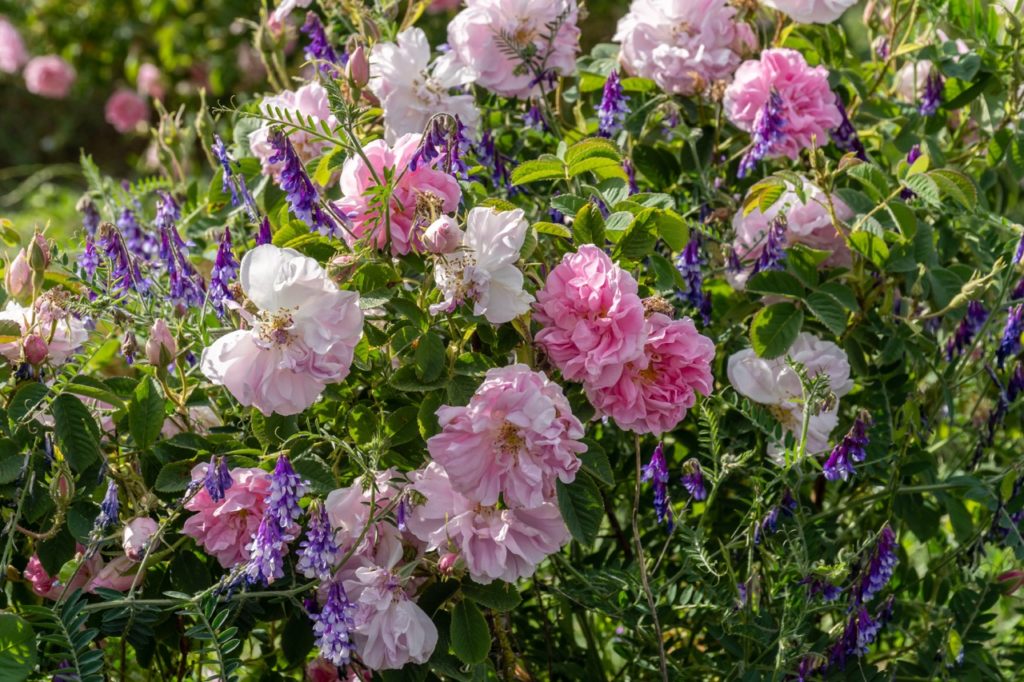
- BOTANICAL NAME: Rosa
- HARDINESS RATING: H6-H7
- PLANT TYPE: perennial
- FLOWERS: varies
- FLOWERING SEASON(S): summer / autumn
- SIZE: 1-1.5m in height, 2.5-4m spread
If you’re looking for an ornamental plant to plant with your lavender, you can’t get much better than roses.
“Our favourite companion plant for lavender would definitely be roses,” says the Butlers.
“The aroma of the two plants combined is lovely!”
Shrub roses in particular are great to plant with lavender shrubs are they thrive in the sun and can tolerate conditions that other varieties might not be able to.
Roses, unfortunately, attract aphids, whilst lavender shrubs attract ladybirds, which are notorious for eating pests.
So, by planting your roses near lavender, it will protect them from aphids and also help them with pollination, all whilst brightening up your garden beds and borders.
“The lower part of many roses are often quite bare, such as Hybrid Teas or upright English Shrub Roses such as Rosa ‘Queen of Sweden’, so Lavender does a good job of covering this up,” adds Roy.
9) Yarrow

- BOTANICAL NAME: Achillea millefolium
- HARDINESS RATING: H7
- PLANT TYPE: perennial
- FLOWERS: cream, white, yellow and pink
- FLOWERING SEASON(S): summer
- SIZE: 0.1-0.5m in height, 0.1-0.5m spread
Like lavender, yarrow is a hardy perennial that thrives in full sun and well-drained soil that can provide a burst of colour to your flower beds and borders.
Yarrow produces clusters of small flowers that appear in summer in shades of pink, white and yellow, so you have a wide range to choose from, but all will go well with the purple flowers of a lavender shrub.
This plant is also a great choice for a wildlife-friendly garden, as its blooms are just as much of a delight to pollinators as they are to us.
10) Ruby Grass
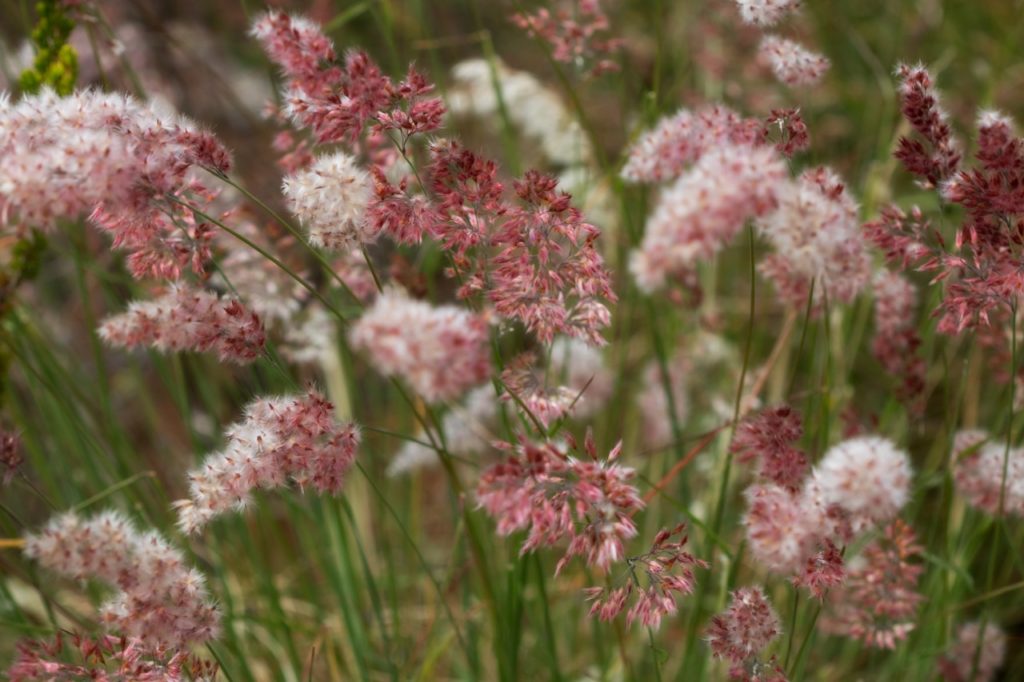
- BOTANICAL NAME: Melinis nerviglumis
- HARDINESS RATING: H2
- PLANT TYPE: perennial / annual
- FLOWERS: pink / white
- FLOWERING SEASON(S): summer / autumn
- SIZE: 0.5-1m in height, 0.1-0.5m spread
Melinis nerviglumis, also known as ruby grass, is a frost-tender perennial that is usually grown as an annual here in the UK.
This grass produces a clump of tall, thin stems that bear cluster of feather-like flowers in summer and autumn that are either white or pink in colour.
Ruby grass can be planted in between the herbs in your garden to provide a grassy backdrop and a subtle show of colour and it will also not require much care once planted out.
11) Sage

- BOTANICAL NAME: Salvia officinalis
- HARDINESS RATING: H5
- PLANT TYPE: herb / perennial
- FLOWERS: blue
- FLOWERING SEASON(S): summer
- SIZE: 0.5-1m in height, 0.5-1m spread
Like lavender, sage is native to the Mediterranean and is a drought-tolerant perennial herb that loves basking in full sun.2Ridley, R. (n.d.). Mediterranean Herbs. The Herb Society. Retrieved March 21, 2023, from https://herbsociety.org.uk/information/gardening-with-herbs/mediterranean-herbs/
Sage is a great herb to grow in your garden because it can be harvested from spring to autumn and will taste great throughout this time period, best used in dishes with squash or as a garnish.3Good Food Team. (2022, June 10). Sage. BBC Good Food. Retrieved March 21, 2023, from https://www.bbcgoodfood.com/glossary/sage-glossary
12) Purple Coneflower
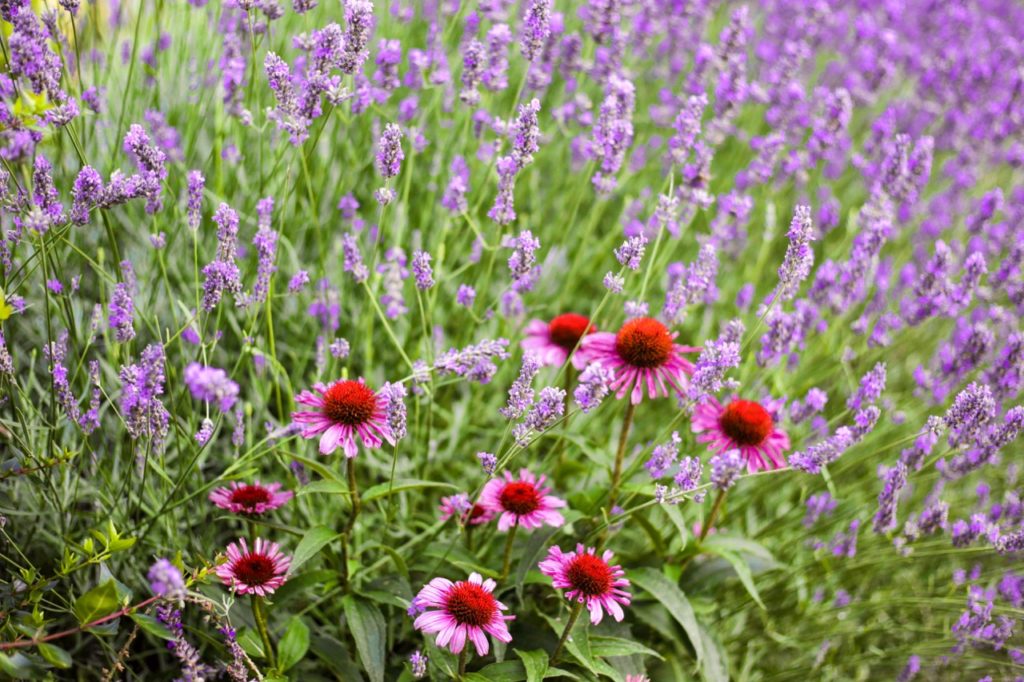
- BOTANICAL NAME: Echinacea purpurea
- HARDINESS RATING: H5
- PLANT TYPE: perennial
- FLOWERS: purple and brown
- FLOWERING SEASON(S): summer / autumn
- SIZE: 1-1.5m in height, 0.1-0.5m spread
Pairing lavender with another purple plant like Echinacea purpurea is bound to be a beautiful sight, but this is not the only reason that these two are a good match.
Purple coneflowers are perhaps even more drought-tolerant than lavender, so this plant will not need any additional watering and will thrive in a well-drained position in full sun.
13) Broccoli
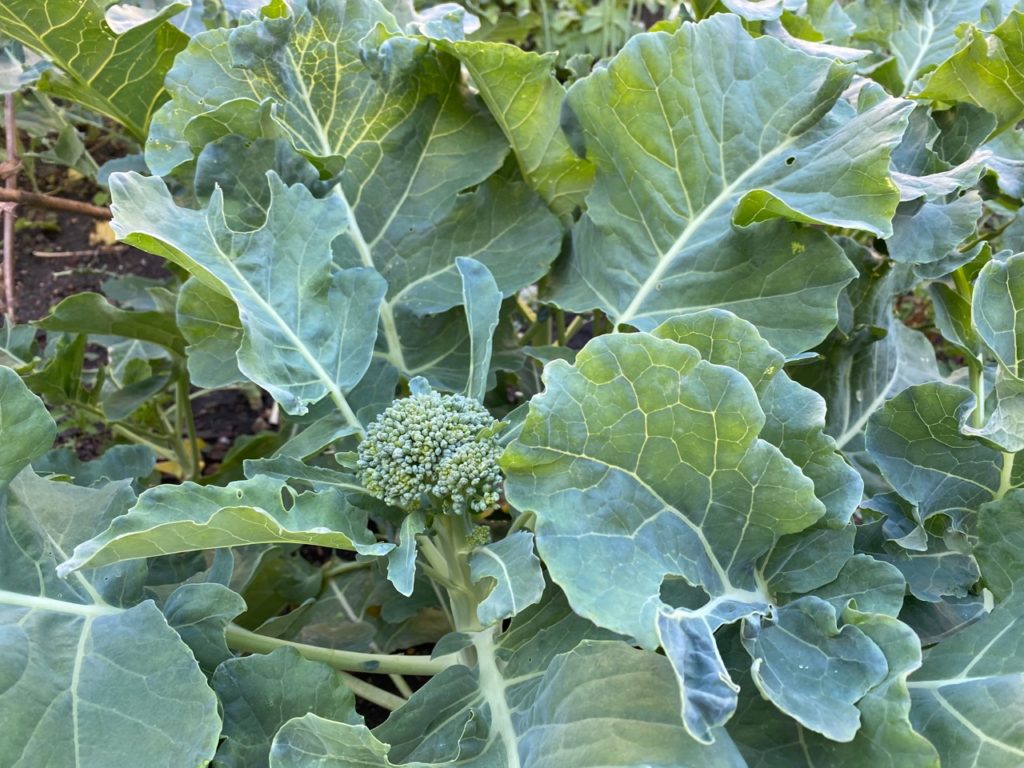
- BOTANICAL NAME: Calabrese
- HARDINESS RATING: H3
- PLANT TYPE: vegetable
- SIZE: 0.1-0.5m in height, 0.1-0.5m spread
As we’ve already mentioned, lavender is a good companion plant for vegetables as its flowers release a scent that can deter pests from munching on your leafy greens.
Broccoli is one of these veggies that will truly reap the benefits that lavender can provide.
The pollinators that lavender will bring to your vegetable patch can help increase the yield of your broccoli and there’s some speculation that lavender can also help deter slugs, which usually love to feast on broccoli and other brassicas.
14) Cardinal Flower
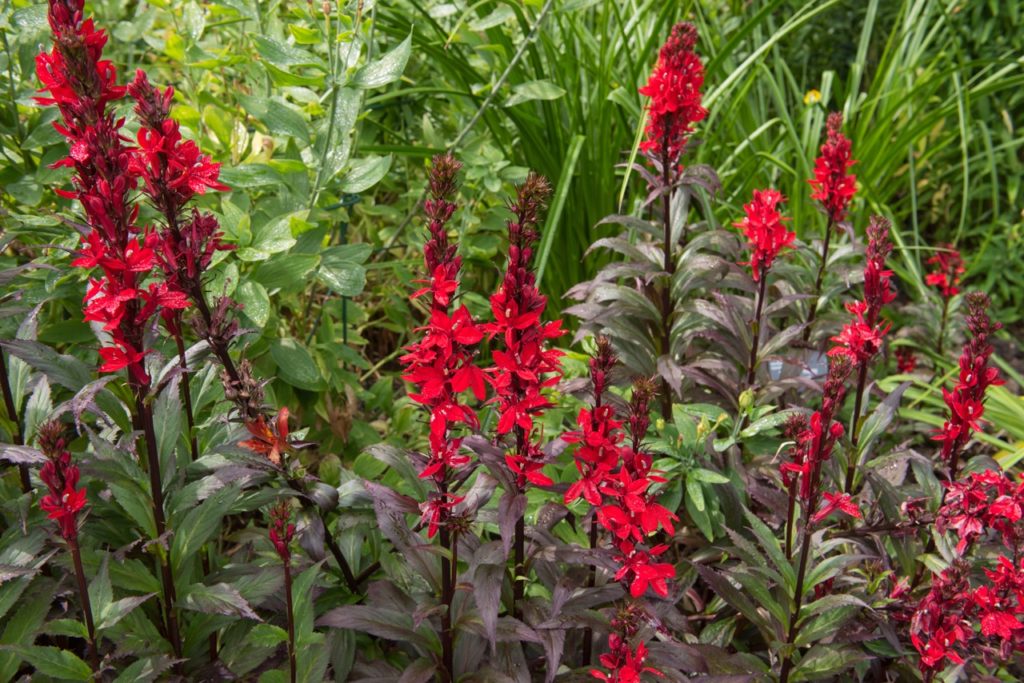
- BOTANICAL NAME: Lobelia cardinalis
- HARDINESS RATING: H3
- PLANT TYPE: perennial
- FLOWERS: red
- FLOWERING SEASON(S): summer / autumn
- SIZE: 0.5-1m in height, 0.1-0.5m spread
The cardinal flower is sure to stand out wherever it is planted, thanks to its bright red flowers that grow on tall spikes up to 1m tall.
This perennial needs to be planted in a loam-based site with poorly-drained soil, so you might be wondering how it can make a good companion plant with lavender, which notoriously favours drier conditions.
Although I would not recommend planting these in the same ground, when placed in containers next to each other, the cardinal flower and lavender will create a stunning display that will encourage pollinators from your area to visit your garden.
15) African Daisy

- BOTANICAL NAME: Osteospermum jucundum
- HARDINESS RATING: H3
- PLANT TYPE: perennial
- FLOWERS: purple
- FLOWERING SEASON(S): summer / autumn
- SIZE: 0.1-0.5m in height, 0.5-1m spread
Blooming well into autumn even when your lavender plants have stopped flowering, African daisies are gorgeous perennials that bear daisy-like flowers in shades of purple from May onwards.
This lovely plant thrives in the same conditions as lavender and, aside from some additional care over winter, should return each year and is relatively low-maintenance.
16) Parsley
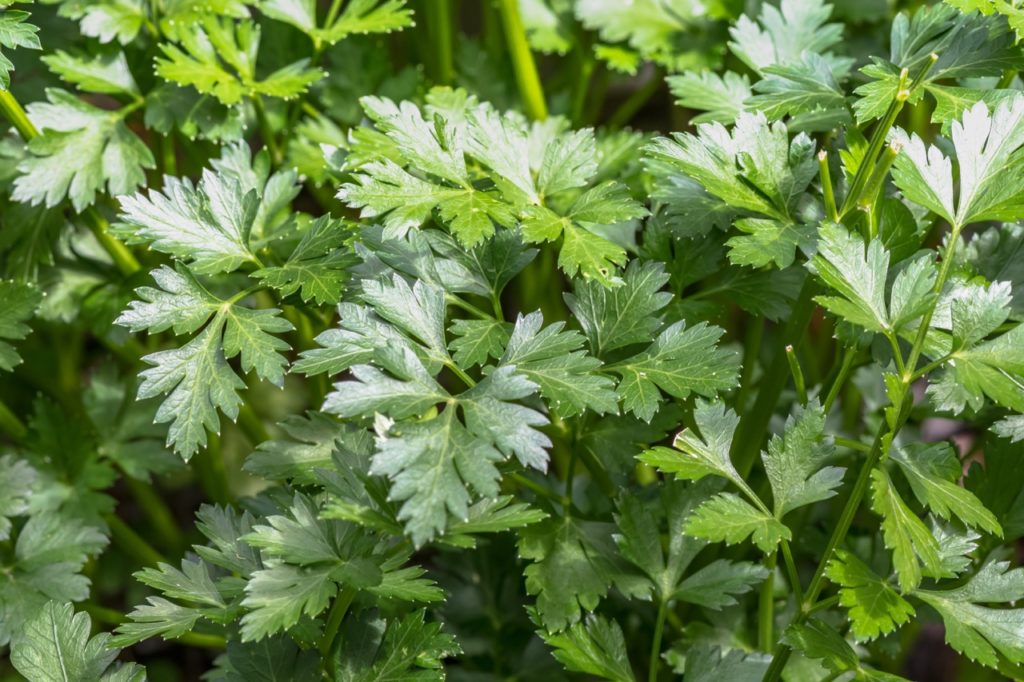
- BOTANICAL NAME: Petroselinum crispum
- HARDINESS RATING: H6
- PLANT TYPE: herb / biennial
- FLOWERS: green and yellow
- FLOWERING SEASON(S): summer
- SIZE: 0.1-0.5m in height, 0.1-0.5m spread
There are mutual benefits when it comes to planting parsley with lavender.
Parsley is a hardy herb that will make a beautiful grassy backdrop when planted near your lavender shrubs.
Lavender is also great for attracting beneficial insects that will feed on pests that frequent parsley, such as aphids and flies.
Be aware that parsley does need watering more frequently than lavender, so make sure that they are planted at a large enough distance apart to ensure they are both receiving the correct care without imposing on the other.
17) Baby’s Breath

- BOTANICAL NAME: Gypsophila paniculata
- HARDINESS RATING: H4
- PLANT TYPE: perennial
- FLOWERS: white
- FLOWERING SEASON(S): spring / summer
- SIZE: 1-1.5m in height, 1-1.5m spread
With a preference for dry, alkaline soils in a site that receives lots of sun, using baby’s breath as a companion plant for lavender is an obvious choice.
The white flowers from this plant that appear throughout the spring and summer months will look great with any plant but will pair particularly well with lavender and its purple blooms.
Although it might need some care over the winter, you should find that baby’s breath is relatively easy to grow.
18) Black-Eyed Susan

- BOTANICAL NAME: Rudbeckia fulgida
- HARDINESS RATING: H6
- PLANT TYPE: perennial
- FLOWERS: yellow, brown and gold
- FLOWERING SEASON(S): summer / autumn
- SIZE: 0.5-1m in height, 0.5-1m spread
Black-Eyed Susan is a common sight in UK gardens and for good reason.
This low-maintenance plant thrives in a range of conditions and looks great doing it, producing yellow, daisy-like flowers in the summer and autumn with brown centres on stems that reach up to 1m in height.
The bright golden blooms will compliment the purple flowers that lavender plants produce, and since both plants are popular with pollinators, why not try planting them together in a wildlife-friendly garden?
19) Rosemary

- BOTANICAL NAME: Rosmarinus officinalis
- HARDINESS RATING: H4
- PLANT TYPE: shrub
- FLOWERS: purple, blue and white
- FLOWERING SEASON(S): spring / summer
- SIZE: 1.5-2.5m in height, 1.5-2.5m spread
I think that rosemary is one of the best plants to grow with lavender.
They both thrive in the same conditions, produce stunning blue and purple blooms at the same time in spring and summer and are also aromatic herbs that don’t overpower each other.
As far as companion plants go, you can’t get much better.
“As Rosemary has a tendency to become a large, sprawling shrub if left unattended, it’s a good idea to prune it back after flowering in the late spring to keep it to size and prevent it from flopping onto the Lavender,” says Roy.
“It can also be grown as a low hedge in the same way as Lavender, so this principle can be applied to have complementary hedges grown together – even forming a pattern to your design!”
20) Blue Fescue

- BOTANICAL NAME: Festuca glauca
- HARDINESS RATING: H5
- PLANT TYPE: grass
- FLOWERS: green
- FLOWERING SEASON(S): summer
- SIZE: 0.1-0.5m in height, 0.1-0.5m spread
To finish up this list I’ve picked Festuca glauca, also known as Blue Fescue, as I think it pairs rather nicely with lavender when planted in rock or gravel gardens or in more traditional cottage garden schemes.
With silvery-blue foliage and green flowers in the summer, this plant is a delight even when planted on its own.
This ornamental grass thrives in full sun and is drought-tolerant so could even be planted out in your herbal beds to create a more natural, grassy look.
References
- 1Why Can Lavender Be Used to Repel Moths? – The Chemistry of Lavender. (2017, July 10). Compound Interest. Retrieved March 21, 2023, from https://www.compoundchem.com/2017/07/10/lavender/
- 2Ridley, R. (n.d.). Mediterranean Herbs. The Herb Society. Retrieved March 21, 2023, from https://herbsociety.org.uk/information/gardening-with-herbs/mediterranean-herbs/
- 3Good Food Team. (2022, June 10). Sage. BBC Good Food. Retrieved March 21, 2023, from https://www.bbcgoodfood.com/glossary/sage-glossary

